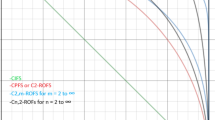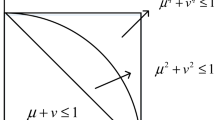Abstract
There are two main issues of fuzzy multi-attribute decision-making: determine the weight of each attribute and choose an appropriate aggregation method to integrate the evaluation information of different attributes. In order to solve the multi-attribute decision-making problem in generalized orthopair fuzzy environment with unknown attribute weights more effectively, we give a decision-making method based on generalized orthopair fuzzy definite integrals. To be specific, we first introduce the complement operations of q-rung orthopair fuzzy numbers, and then investigate the multiplicative q-rung orthopair fuzzy calculus. Through the complement operations, we establish the mutual conversion formula between additive and multiplicative q-rung orthopair fuzzy calculus theory. Then, we give a multiplicative integral-based q-rung orthopair fuzzy multi-attribute decision-making method, and discuss the relationship between the q-rung orthopair fuzzy definite integrals and the q-rung orthopair fuzzy weighted geometric operator. Compared with traditional decision-making methods, this method does not rely on subjective weight information, which is especially important when dealing with large sample data. Finally, the application of election is studied to verify the feasibility and effectiveness of the proposed method. With the introduction of generalized orthopair fuzzy sets, the expression form of election evaluation information has been expanded. We also provide some examples to compare the obtained results with the results generated by the addition operation and reveal the correlation between them.
Similar content being viewed by others
References
Ai Z H, Xu Z S (2017). Line integrals of intuitionistic fuzzy calculus and their properties. IEEE Transactions on Fuzzy Systems 26(3):1435–1446.
Baas S M, Kwakernaak H (1977). Rating and ranking of multiple-aspect alternatives using fuzzy sets. Automatica 13(1):47–58.
Bellman R E, Zadeh L A (1970). Decision-making in a fuzzy environment. Management Science 17(4):B141.
Chen S J, Hwang C L (1992). Multiple attribute decision making — An overview. Fuzzy Multiple Attribute Decision Making: 16–41.
Chen T Y, Li C H (2010). Determining objective weights with intuitionistic fuzzy entropy measures: A comparative analysis. Information Sciences 180(21):4207–4222.
Gao J, Liang Z L, Shang J, Xu Z S (2019). Continuities, derivatives and differentials of q-Rung orthopair fuzzy functions. IEEE Transactions on Fuzzy Systems 27(8):1687–1699.
Gao J, Liang Z L, Xu Z S (2020). Additive integrals of generalized orthopair fuzzy functions. IEEE Transactions on Cybernetics 50(10):4406–4419.
Hwang C L, Yoon K (1981). Methods for multiple attribute decision making. Multiple Attribute Decision Making. Springer, 58–191.
Kou G L, Chang S (2014). A cosine maximization method for the priority vector derivation in AHP. European Journal of Operational Research 235(1):225–232.
Krishankumar R, Gowtham Y, Ahmed I, Ravichandran K, Kar S (2020). Solving green supplier selection problem using q-rung orthopair fuzzy-based decision framework with unknown weight information. Applied Soft Computing 94:106431.
Lei Q, Xu Z S (2015). Fundamental properties of intuitionistic fuzzy calculus. Knowledge-Based Systems 76:1–16.
Lei Q, Xu Z S (2016). Relationships between two types of intuitionistic fuzzy definite integrals. IEEE Transactions on Fuzzy Systems 24(6):1410–1425.
Li G X, Kou G, Peng Y (2015). Dynamic fuzzy multiple criteria decision making for performance evaluation. Technological and Economic Development of Economy 21(5):705–719.
Liu P D, Liu J L (2018). Some q-Rung orthopai fuzzy Bonferroni mean operators and their application to multiattribute group decision making. International Journal of Intelligent Systems 33(2):315–347.
Liu P D and Wang P (2018). Some q-rung orthopair fuzzy aggregation operators and their applications to multiple-attribute decision making. International Journal of Intelligent Systems 33(2):259–280.
Liu P D, Wang P (2018). Multiple-attribute decision-making based on Archimedean Bonferroni Operators of q-rung orthopair fuzzy numbers. IEEE Transactions on Fuzzy Systems 27(5):834–848.
Liu P D, Chen S M, Wang P (2020). Multiple-attribute group decision-making based on q-rung orthopair fuzzy power maclaurin symmetric mean operators. IEEE Transactions on Systems, Man, and Cybernetics: Systems 50(10):3741–3756.
Liu Z M, Liu P D, Liang X (2018). Multiple attribute decision-making method for dealing with heterogeneous relationship among attributes and unknown attribute weight information under q-rung orthopair fuzzy environment. International Journal of Intelligent Systems 33(9):1900–1928.
Nabavi K S, Abadi M, Kabir E (2010). A PSO-based weighting method for linear combination of neural networks. Computers & Electrical Engineering 36(5):886–894.
Riaz M, Saabun W, Farid H M A, Ali N, Watrbski J (2020). A robust q-rung orthopair fuzzy information aggregation using Einstein operations with application to sustainable energy planning decision management. Energies 13(9):2155.
Saaty T L (1977). A scaling method for priorities in hierarchical structures. Journal of Mathematical Psychology 15(3):234–281.
Shao Y B, Zhuo J L (2020). Basic theory of line integrals under the q-rung orthopair fuzzy environment and their applications. International Journal of Intelligent Systems 35(7):1163–1199.
Shu X Q, Ai Z H, Xu Z S, Ye J M (2019). Integrations of q-rung orthopair fuzzy continuous information. IEEE Transactions on Fuzzy Systems 27(10):1974–1985.
Wang T C, Lee H D (2009). Developing a fuzzy TOPSIS approach based on subjective weights and objective weights. Expert Systems with Applications 36(5):8980–8985.
Wang J, Zhang R T, Zhu X M, Zhou Z, Shang X P, Li W Z (2019). Some q-rung orthopair fuzzy Muirhead means with their application to multi-attribute group decision making. Journal of Intelligent & Fuzzy Systems 36(2):1599–1614.
Wei G W, Gao H, Wei Y (2018). Some q-rung orthopair fuzzy Heronian mean operators in multiple attribute decision making. International Journal of Intelligent Systems 33(7):1426–1458.
Wei G W, Wei C, Wang J, Gao H, Wei Y (2019). Some q-rung orthopair fuzzy maclaurin symmetric mean operators and their applications to potential evaluation of emerging technology commercialization. International Journal of Intelligent Systems 34(1):50–81.
Xia M M, Xu Z S (2012). Entropy/cross entropy-based group decision making under intuitionistic fuzzy environment. Information Fusion 13(1):31–47.
Xu Z S (2007). Models for multiple attribute decision making with intuitionistic fuzzy information. International Journal of Uncertainty, Fuzziness and Knowledge-Based Systems 15(03):285–297.
Xu Z S (2010). A deviation-based approach to intuitionistic fuzzy multiple attribute group decision making. Group Decision and Negotiation 19(1):57–76.
Xu Z S (2011). Intuitionistic fuzzy multiattribute decision making: an interactive method. IEEE Transactions on Fuzzy Systems 20(3):514–525.
Yager R R (1977). Multiple objective decision-making using fuzzy sets. International Journal of Man-Machine Studies 9(4):375–382.
Yager R R (2017). Generalized orthopair fuzzy sets. IEEE Transactions on Fuzzy Systems 25(5):1222–1230.
Yager R R, Alajlan N (2017). Approximate reasoning with generalized orthopair fuzzy sets. Information Fusion 38:65–73.
Yager R R, Alajlan N, Bazi Y (2018). Aspects of generalized orthopair fuzzy sets. International Journal of Intelligent Systems 33(11):2154–2174.
Yang W, Pang Y F (2019). New q-rung orthopair fuzzy partitioned Bonferroni mean operators and their application in multiple attribute decision making. International Journal of Intelligent Systems 34(3):439–476.
Zhang L, Zhou W D (2011). Sparse ensembles using weighted combination methods based on linear programming. Pattern Recognition 44(1):97–106.
Zhao H, Xu Z S (2016). Intuitionistic fuzzy multi-attribute decision making with ideal-point-based method and correlation measure. Journal of Intelligent & Fuzzy Systems 30(2):747–757.
Acknowledgments
The authors would like to thank the referees for their help to improve the quality of the paper.
Author information
Authors and Affiliations
Corresponding author
Additional information
Jie Gao is an assistant professor with School of Business Administration, Southwestern University of Finance and Economics, Chengdu. Her current research interests include decision analysis, information fusion, and fuzzy systems.
Chao Zhong is a graduate student with School of Business Administration, Southwestern University of Finance and Economics, Chengdu. His current research interests include big data decision-making, platform economics and data mining.
Yunshu Mao is a graduate student with School of Business Administration, Southwestern University of Finance and Economics, Chengdu. Her current research interests include decision theory and method, big data analytics and machine learning.
Rights and permissions
About this article
Cite this article
Gao, J., Xu, Z., Zhong, C. et al. Multiplicative Integral Theory of Generalized Orthopair Fuzzy Sets and Its Applications. J. Syst. Sci. Syst. Eng. 31, 457–479 (2022). https://doi.org/10.1007/s11518-022-5533-9
Published:
Issue Date:
DOI: https://doi.org/10.1007/s11518-022-5533-9




